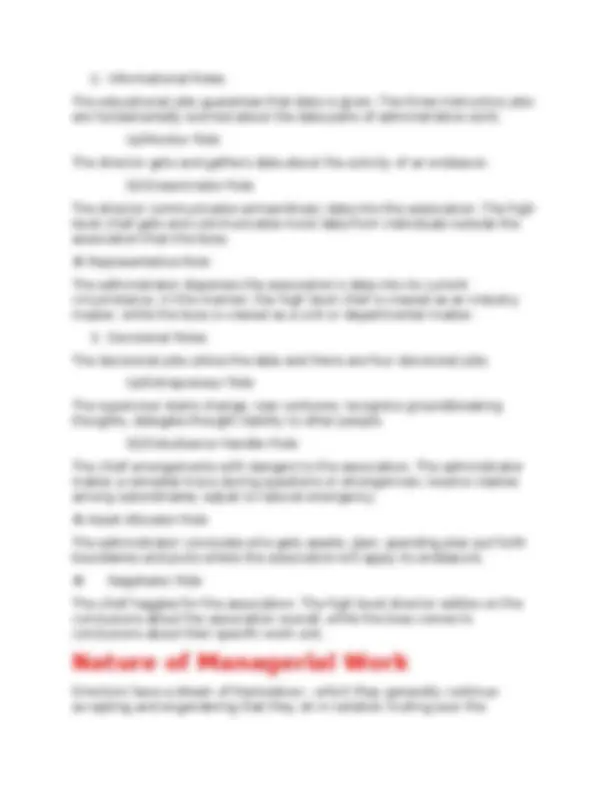








Study with the several resources on Docsity

Earn points by helping other students or get them with a premium plan


Prepare for your exams
Study with the several resources on Docsity

Earn points to download
Earn points by helping other students or get them with a premium plan
Community
Ask the community for help and clear up your study doubts
Discover the best universities in your country according to Docsity users
Free resources
Download our free guides on studying techniques, anxiety management strategies, and thesis advice from Docsity tutors
It is the important notes about the business management.
Typology: Study notes
1 / 10

This page cannot be seen from the preview
Don't miss anything!







The development and development of progress the executives as a discipline has seen a brilliant ascent over the three fundamental times of the conclusive past, advancing present and the formalized and extending future. The fundamental years before the 1990’s saw scholastics starting to characterize and comprehend the actual rudiments of progress the executives and frameworks encountering, responding and figuring out how to adjust to change. 1910s-1940s: Management as Science The executives as Science was created in the mid twentieth 100 years and zeroed in on expanding efficiency and productivity through normalization, division of work, centralization and order. An exceptionally top down’ administration with severe command over individuals and cycles ruled across businesses. 1950s-1960s: Functional Organizations Because of developing and more mind boggling associations, the 1950’s and 1960’s saw the rise of practical associations and the Human Resource (HR) development. Directors started to comprehend the human consider creation and efficiency and apparatuses, for example, objective setting, execution audits and sets of expectations were conceived. 1970s: Strategic Planning In the 1970’s we changed our concentration from estimating capability to asset designation and apparatuses like Strategic Planning (GE), Growth Share Matrix (BCG) and SWOT were utilized to formalize vital arranging processes. Following a very long while of ‘best practice and ‘one size fits all’ arrangements, scholastics started to creating possibility hypotheses. 1980s: Competitive Advantage As the business climate became progressively cutthroat and associated, and with a blossoming the executives consultancy industry, Competitive benefit turned into a need for associations in the 1980’s. Devices like Total Quality Management (TQM), Six Sigma and Lean were utilized to quantify processes and further develop efficiency Employees were more required by gathering information, however choices were as yet made at the top, and objectives were utilized to oversee individuals and keep up with control.
1990s: Process Optimization Benchmarking and business process reengineering became famous in the 1990’s, and by the center of the 10 years, 60% of Fortune 500 organizations professed to have plans for or have previously started such tasks. TQM, Six Sigma and Lean stayed famous and a more all encompassing, association wide methodology and system execution made that big appearance with instruments, for example, Strategy Maps and Balance Scorecards. 2000s: Big Data Generally determined by the counseling business under the standard of Big Data, associations in the 2000’s begun to zero in on involving innovation for development and worth creation. In the mean time, oversaturation of existing business sector space headed to ideas like Blue Ocean Strategy and Value Innovation.
Portioning the administration of an association into levels is crucial to keeping up with the efficiency and work execution of representatives. Despite the fact that when there is an adjustment of the size of the business or the labor force, there would likewise be an adjustment of the quantity of levels of the administration. The principal levels of the executives are:
This degree of the board comprises of departmental heads, for example, buy division head, outreach group head, finance administrator, showcasing chief, boss, plant director, and so on. Individuals of this gathering are liable for executing the plans and approaches made by high level. They go about as a connecting pin among top and lower level administration. They additionally practice the elements of high level for their specialty as they make arrangements and strategies for their specialization, put together and gather the assets and so on. Principal elements of center level administration are: (a) Interpretation of strategies outlined by top administration to bring down level. Center level administration go about as connecting pin between high level and lower level administration. They just make sense of the primary plans and strategies outlined by high level administration to bring down level. (b) Organizing the exercises of their area of expertise for executing the plans and arrangements. By and large center level directors are the top of some division. So they put together every one of the assets and exercises of their area of expertise. © Finding out or enrolling/choosing and naming the necessary workers for their specialization. The center level administration chooses and names representatives of their specialty. (d) Motivating the people to perform to their best capacity. The center level chiefs offer different impetuses to representatives so they get roused and perform to their best capacity € Controlling and teaching the representatives, setting up their exhibition reports and so forth. The center level supervisors keep a watch on the exercises of low level chiefs. They set up their exhibition evaluation reports. (f) Cooperate with different divisions for smooth working. (g) Implementing the plans outlined by high level.
laborers and report to the center level administration. They are additionally answerable for keeping up with discipline among the laborers. Elements of lower level administration are: (a) Representing the issues or complaints of laborers before the center level administration. The administrative level supervisors are straightforwardly connected with subordinates so they are the ideal people to figure out the issues and complaints of subordinates. They pass these issues to center level administration. (b) Maintaining great working circumstances and creating solid relations among prevalent and subordinate. The administrative chiefs give great working circumstances and establish steady workplace which further develop relations among managers and subordinates. © Focusing on security of laborers. Administrative level directors give completely safe workplace for laborers.
Administrative Skills Supervisors at each level in the administration ordered progression should practice three fundamental kinds of abilities: specialized, human, and calculated. All supervisors should procure these abilities in fluctuating extents, albeit the significance of every classification of expertise changes at various administration levels. Abilities Top Management Cond Applied/ Human Levels Center Management Oversight Specialized Ability Distribution at Various The board Levels
degrees relying upon the level and capability of the board. The ten jobs are portrayed exclusively, however they structure a coordinated entirety. The Managerial Roles Relational
Directors have a dream of themselves – which they generally continue accepting and engendering that they sit in isolation mulling over the